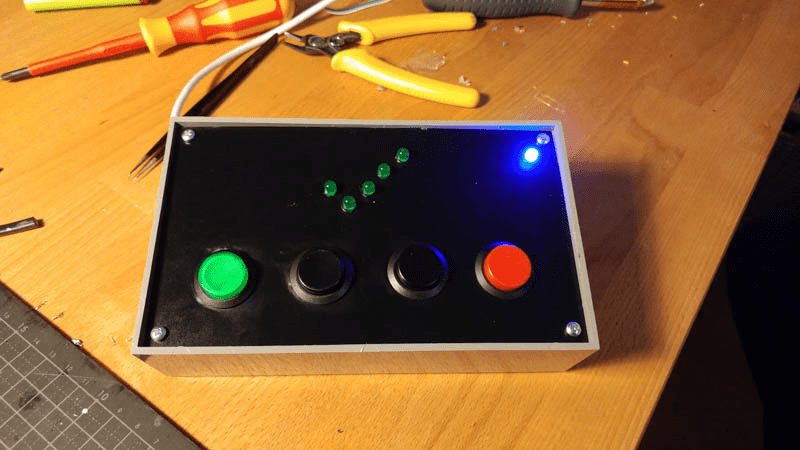It’s always great to see people who haven’t had the opportunity to work with hardware like the Raspberry Pi before come up with a great project and have fun putting it together. [Katja]’s company has a two-day hackfest where employees can work on some cool non-work-related projects. [Katja]’s team decided to use a Raspberry Pi and some buttons and LEDs to create a ‘happiness tracker‘ for the company.
The resulting project is mounted near the entrance to the office and when they come in or leave, an employee can push one of four buttons to indicate their mood at the time, ‘bad,’ ‘not so good,’ ‘good’ or ‘super.’ The result is tracked and an overall impression of the office’s happiness is the result.
The project consists of the aforementioned Raspberry Pi, four push buttons, five LEDs that animate when a button is pressed and another LED that shows the system is currently up and working. When a user presses a button, the five LEDs animate in the shape of a check mark to show that the button press was successful. A Python script running at startup on the Pi takes care of detecting button pressing, lighting LEDs and sending a message to the server which monitors the level of happiness.
It’s a simple project, but that’s exactly what you need when you start with hardware you haven’t worked with before. It seems like [Katja]’s team had fun building the project and they hope that this can help gauge the overall wellbeing of the office. [Katja]’s blog post has an embedded video of the project in action. In the meantime, check out this bit of facial recognition software that determines how happy you are based on your smile, or this project that lets you know how happy your plant is.
















Great idea, and great job, Katja!
[Finally! Something a Raspberry Pi can handle.]
Thank you so much, Henry!
http://imgur.com/a/oyRZa
The cartoon doesn’t really work. Bloke with 555 timer in his head goes to hospital (Good idea!), but instead of getting treatment insults some bloke in a hospital bed (who, why?) and makes him cry???
1/10, try harder.
I don’t get it either, but 555-Head-Man could be the unofficial mascot of the Hackaday Commenteers. I think we can work with this…
You could be right. Long live Timer Head.
In South Australia there is a chain of petrol stations/fast food outlets/grocery providers that have had similar tech to this for some time at their entrance for customer service ratings.
I could have made that cartoon with an Arduino.
I absolutely hate it when I am asked to rate something and there is no “neutral” option.
Neutral is easy, just don’t vote. Mathematically it’s the same thing.
That’s why it is often omitted. People tend to take the safe middle road. It is likely that four options yield a more representative result than five. The latter will inevitably have lots of people on the extremes and in the middle.
Follow the first-paragraph link to Katja’s article describing the team’s effort. Oh, and don’t turn on the Translate button. I missed it on first reading, and had a very pleasant experience. It’s amazing how much German you can learn from a really well-written article coupled with outstanding pictures.
“Besides a mathematical inclination, an exceptionally good mastery of one’s native tongue is the most vital asset of a competent programmer.”–Edsger Djikstra
The high level of attention to detail and construction–mechanical and electronic–is extremely well done; even the quality of the article is WELL above average. This type effort makes one hope for much more from this quarter. We all wish you and your team the very best, and please: keep it up.
I see a patent infringement: https://www.google.com/patents/US20120208165
Sad, isn’t it?
It’s time to throw the whole patent system overboard and start anew.
I just wonder how to interpret the results – if people come in happy in the morning and leave sad in the evening, then what does this mean? Has all the work made them sad or are they so happy at work that they are sad that they have to leave ? :-)
It means ‘Don’t sign anything.